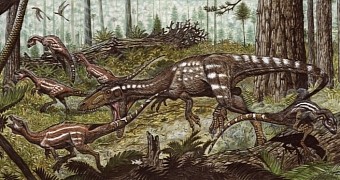A paper published in the journal Royal Society Open Science this October 8 announces the discovery of a previously undocumented species of predatory dinosaur.
The creature, whose appearance is reconstructed in the image accompanying this article, is said to have populated present-day Venezuela millions of years ago, during the early Jurassic period.
Thus, the existence of this species, now named Tachiraptor admirabilis, was documented with the help of the 200-million-year-old fossilized remains unearthed at a site in the northernmost branch of the Andes Mountains towards the beginning of 2013.
At the time these beasts roamed the Earth, Venezuela was part and parcel of a supercontinent dubbed Pangea. In time, this supercontinent broke apart, and most of the landmasses that our planet is now home to were created.
Not your usual ancient beast
In their paper in the journal Royal Society Open Science, the paleontologists behind this find explain that, contrary to what some might assume, this ancient predatory beast was by no means what some would call big.
Having analyzed the skeletal remains of the specimen unearthed in the Andes Mountains, specialists concluded that the average Tachiraptor admirabilis measured around 4.9 to 6.5 feet (1.5 to 2 meters) in length, Live Science informs.
Size-wise, this recently discovered two-legged predatory dinosaur species was not all that different to a run-of-the-mill puma. Still, it was well equipped to navigate its surroundings and secure its next meal.
More precisely, Tachiraptor admirabilis was tough enough to populate a natural ecosystem that was also home to several erupting volcanoes, and was agile enough to catch and kill both other dinosaurs and lizards.
“Tachiraptor was probably a generalist predator that ate anything it could get, such as small dinosaurs and other vertebrates, such as lizards,” researcher Max Langer with the University of São Paulo in Brazil told the press in an interview.
The importance of this find
What's interesting is that this two-legged puma-sized ancient creature is the first predatory dinosaur to have until now been unearthed in Venezuela. In fact, paleontologists say that just one other dinosaur has so far been documented in this country.
This second long-lost animal was a plant-eater and grew to about the size of a fox. Based on information obtained while analyzing its skeletal remains, specialists concluded that it too used to walk around on its hind legs.
Paleontologists hope that, in time, they will find other dinosaur fossils in present-day Venezuela. They are confident that, by studying them, they will reach a better understanding of the evolution of these animals during the early Jurassic.

 14 DAY TRIAL //
14 DAY TRIAL //